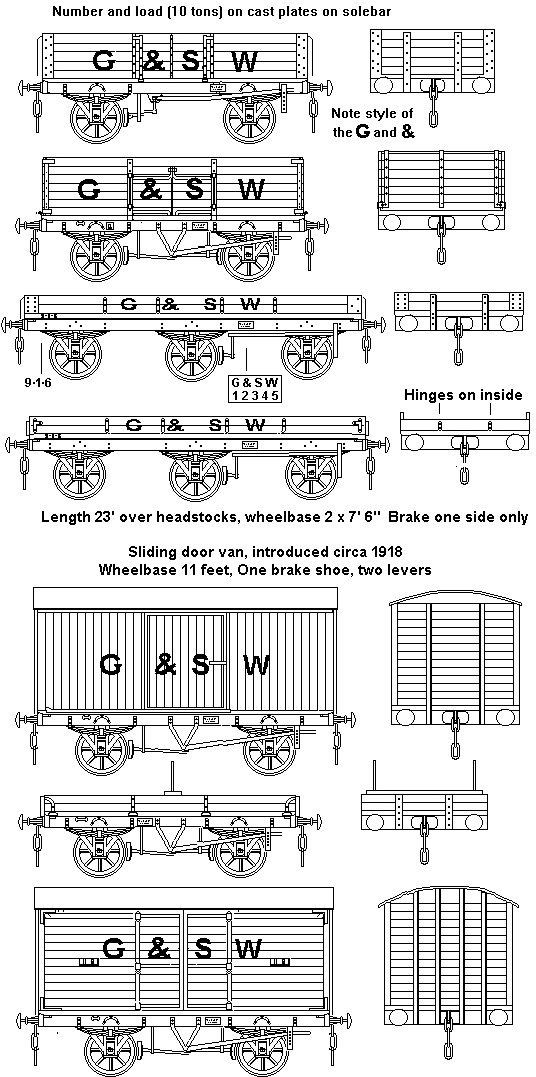
Glasgow & South Western Railway
(Note: Numbers in brackets refer to specific references)
The origins of the railway were a colliery line near Glasgow in 1808 and was probably the first passenger railway line as it operated a horse drawn service taking weavers from Kilmarnock to the port of Troon. The G&SW Rly was formed in 1850 by the amalgamation of the Glasgow, Paisley, Kilmarnock and Air Rly with the Glasgow Carlisle and Dumfries Rly. The G&SW ran from Glasgow St Enoch and served Largs, Dumfries and Greenock. It reached as far south as Gretna on the Scotland - England border but had running powers
over the Caledonian line to reach Carlisle. It entered into several join operations with the Caledonian, North British and companies and G&SW trains served a triangular area between Glasgow, Carlisle and Stranraer. This company had a very close working relationship with the , they even tried to merge in the 1870's but this plan failed. When the opened the Settle & Carlisle route the G&SW allowed it to run into Dumfries, Kilmarnock and Glasgow with connections to south west Scotland. The services on this route were frequent and made use of Pullman cars, trains of fully fitted freight also used the route. There were coal mines at Kilmarnock, Cumnock and Dalmellington, iron works at Kilwinning, explosives at the Nobel Industries plant at Ardeer and of course the shipping and ship building on the Clyde.
The G&SW was one of the companies which liked the mineral wagon with end doors at both ends, as shown in the sketch below, and they operated a fleet of four wheel steel bodied hoppers for ore and limestone to the iron works, furnaces and shipping ports.
Goods stock was painted rather a light grey, similar I believe to the grey, lettering was white. The number and load details (at least on open wagons) were not painted on the vehicle sides but were recorded on cast plates bolted to the solebar.
Passenger livery was an all-over maroon, essentially the same as the Midland Railway livery, with yellow lettering. This company actually built some coaches to MR designs at its works.
Fig ___ GSWR

The G&SW operated a number of pleasingly different goods vehicles, the bolster wagon is slightly unusual in having two-plank drop sides and a swiveling bolster raised up inside the wagon. This seems to have been a Scottish idea as the Caledonian operated some dual purpose timber and ore wagons with a one plank body and raised bolster. I am not sure what the secondary purpose of the G&SWR type might have been. Having the bolster raised in this way would make operation with other company bolsters problematic but this would only have become a real problem after the Grouping of 1923 as I believe single bolster wagons were not in the post World War One common user scheme.
The six wheeled plate wagon came in two variants, one with drop down ends the other with fixed ends, on both designs the two plank sides dropped down. The details of this wagon were kindly supplied by the G&SWR Association. The GSWRA is currently undertaking a long term study into the freight stock operated by the company.
References:
The Glasgow & South Western Railway by C Highet, published by Oakwood in 1965. A slim volume with photographs and maps supporting a good potted history of the line
Societies:
The Glasgow and South Western Railway Association
Available Models.
No specific models for the freight stock of this company have been found in N Gauge/2mm Scale.
Acknowledgements
Thanks are due to Stewart Clinton and Stuart Rankin of the G&SWR Association for their assistance in the preparation of this article. The Association is currently working on a compilation of a comprehensive wagon list with detailed drawings, dates and vehicle numbers for the line.